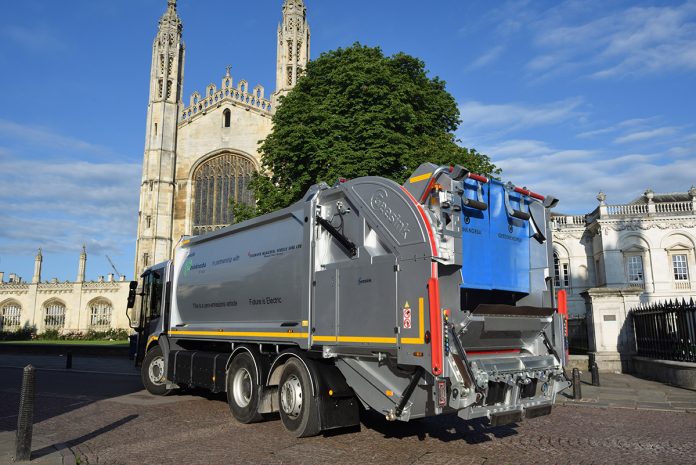Looking for an alternative to diesel but not sure if electric is the right solution for your waste fleet? André Lagendijk from Geesinknorba answers the most common questions about the company’s ground-breaking Li-On Power Pro electric RCV
Our Li-On Power Pro (LPP) technology is the result of more than 15 years of research and development into electric vehicles and represents a step towards totally emissions-free waste collection.
Our first fully electric RCV was launched in 2017. Based on lithium-ion batteries, the LPP is a chassis-independent system that only requires a high-voltage connection and CAN bus connection to and from the chassis. The intelligent LPP module connects with any electric chassis and controls the body dynamically for highly economical energy consumption.
What types of RCVs are available with this technology?
The initial vehicle was 18-tonnes. Since then, we have implemented the LPP module on RCVs from 12 to 26 tonnes. All our bodies and compaction mechanisms are available as hybrid or full electric, allowing customers to choose the vehicle most suited to their operations. Our hydraulics systems are designed for easy migration to both Li-On (hybrid) and Li-On Power Pro, so operators can purchase a diesel now in the knowledge that it can be converted to electric in the future.
What are the benefits?
The transport sector is the biggest contributor to the UK’s greenhouse gas emissions. It is also largely responsible for the air quality crisis in our towns and cities. Ultimately, petrol and diesel will be phased out and operators will need alternative solutions. Already London has implemented the Ultra-Low Emissions Zone and other cities will follow suit. Our electric RCV meets even the most stringent requirements of these zones.
An RCV usually operates 260 days a year and consumes around one litre of diesel every kilometre. The EU’s VECTO tool estimates emissions of 3.13kg of CO2 per litre of diesel. That’s around 81 tonnes of CO2 per year, per vehicle. Diesel and petrol vehicles are also responsible for other harmful pollutants, which cause health problems and contribute to global warming. An electric RCV is totally emissions-free in operation, and running and maintenance costs are significantly lower.
How much will it cost?
Don’t be put off by the higher initial purchase price. While electric may cost two to three times as much upfront as a diesel, Total Cost of Ownership is the important figure. Running costs over a nine-year period will be significantly lower than an ICE-propelled RCV and you can expect to break even on TOC after 4.5 years.
These vehicles are extremely energy-efficient, consuming between 0.8 and 1.5kWh per kilometre and approximately 1.4kWh per tonne of collected, compacted and dumped waste. Figures from UK trials suggest that operators can expect to save up to £50,000 per vehicle, per year at current UK fuel prices. However, running costs will differ for each operation and will depend on a range of factors, including shift length, tonnage collected, number of containers lifted, average distance travelled, and even driving style.
Can these vehicles perform to the same standard as a diesel RCV?
This technology is no longer in the experimental stage. Our electric RCVs are fully fit for purpose and their performance has been proven in numerous trials. One vehicle has been in operation for more than a year in the UK. Another is about to go into service. There are ten vehicles operating throughout Europe, in Holland, Norway, and Spain. Feedback has been very positive, with both chassis and body exceeding expectations. And drivers love them. Once they adjust to the different driving style, they don’t want to give them back.
What kind of shift lengths are they capable of?
The vehicle can easily perform an eight-hour shift. In fact, in trials in Stockton-on-Tees and the City of Westminster, the vehicle achieved shifts of nine hours with no problems. In Westminster, battery capacity utilisation was just 73%.
Does the vehicle have a maximum range?
This depends on the operation and battery size. An electric RCV has a range of approximately 150km to 500km and can carry battery packs from 130kWh up to 600kWh. The size of the battery pack is calculated based on both the desired range and the average amount of waste collected per day. Our UK trial vehicles averaged between 88km and 175km per shift, but, as with running costs, use will determine range.
What infrastructure is required?
Initially, the requirement is for 400VAC 3-phase 63A charging, which requires no special infrastructure. It may be possible to use 32A charging. Depending on the size of the battery pack, this may take nine to 10 hours for a full charge. DC fast charging requires the installation of a special charger and infrastructure but a 150kW DC unit will charge a vehicle in one to two hours.
What about battery maintenance?
The battery pack is built up in two separate compartments, usually in place of the fuel tanks. These are encased in water- and fireproof boxes and servicing should only be carried out by qualified engineers. The Battery Management System monitors battery health and performance. In the rare event of a weak cell, the BMS will alert the operator and the cell can be replaced relatively easily. The batteries are guaranteed for 60 months or 3,000 full charging cycles. We provide training on how to optimise battery life and charging disciplines.
Can I charge my RCV using renewable sources?
Yes, but you will need to install appropriate infrastructures such as PV panels or wind turbines. This will require in-depth analysis to align the charging requirements of the vehicle with the number of PV panels and/or turbines. However, it is the most direct and the greenest method of charging.
Can I convert my whole fleet to electric?
In theory, yes. However, there are still barriers to large-scale adoption. Electric chassis are currently only available as conversions on chassis from manufacturers such as Emoss, E-Force One, Electra, DAF, Man, Mercedes-Benz, and Iveco. There is not yet a factory solution. Then there’s infrastructure. Many depots lack the means of charging multiple vehicles. Most fleet operators need to upgrade their infrastructure before they can expand their EV fleets and this requires a multi-partner approach.
On the other hand, battery development is continuing at a rapid pace. We are likely to see batteries with double the capacity and half the weight in a few years, as well as advances such as solid-state batteries and even wireless charging. Consider how quickly smartphones developed. Alternative fuel technology is just at the beginning of its journey.
Geesinknorba Group
Tel: +44 (0)1443 222 301
Please note: This is a commercial profile











